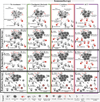Immune Effects of Chemotherapy, Radiation, and Targeted Therapy and Opportunities for Combination With Immunotherapy
- PMID: 26320064
- PMCID: PMC4955940
- DOI: 10.1053/j.seminoncol.2015.05.007
Immune Effects of Chemotherapy, Radiation, and Targeted Therapy and Opportunities for Combination With Immunotherapy
Abstract
There have been significant advances in cancer treatment over the past several years through the use of chemotherapy, radiation therapy, molecularly targeted therapy, and immunotherapy. Despite these advances, treatments such as monotherapy or monomodality have significant limitations. There is increasing interest in using these strategies in combination; however, it is not completely clear how best to incorporate molecularly targeted and immune-targeted therapies into combination regimens. This is particularly pertinent when considering combinations with immunotherapy, as other types of therapy may have significant impact on host immunity, the tumor microenvironment, or both. Thus, the influence of chemotherapy, radiation therapy, and molecularly targeted therapy on the host anti-tumor immune response and the host anti-host response (ie, autoimmune toxicity) must be taken into consideration when designing immunotherapy-based combination regimens. We present data related to many of these combination approaches in the context of investigations in patients with melanoma and discuss their potential relationship to management of patients with other tumor types. Importantly, we also highlight challenges of these approaches and emphasize the need for continued translational research.
Copyright © 2015 Elsevier Inc. All rights reserved.
Conflict of interest statement
Conflicts of interest: J.A.W. has honoraria from speakers’ bureau of Dava Oncology and is an advisory board member for GlaxoSmithKline and Roche/Genentech. RJ.S. is a consultant for Astex. No conflicts of interest were disclosed by the other authors.
Figures


Similar articles
-
Immunotherapy for triple-negative breast cancer: Existing challenges and exciting prospects.Drug Resist Updat. 2017 May;32:1-15. doi: 10.1016/j.drup.2017.07.002. Epub 2017 Aug 19. Drug Resist Updat. 2017. PMID: 29145974 Review.
-
The Role of Adaptive Immunity in the Efficacy of Targeted Cancer Therapies.Trends Immunol. 2016 Feb;37(2):141-153. doi: 10.1016/j.it.2015.12.007. Epub 2016 Jan 7. Trends Immunol. 2016. PMID: 26778079 Free PMC article. Review.
-
Immune targets in the tumor microenvironment treated by radiotherapy.Theranostics. 2019 Jan 30;9(5):1215-1231. doi: 10.7150/thno.32648. eCollection 2019. Theranostics. 2019. PMID: 30867826 Free PMC article. Review.
-
Combining targeted therapy with immunotherapy. Can 1+1 equal more than 2?Semin Immunol. 2016 Feb;28(1):73-80. doi: 10.1016/j.smim.2016.01.001. Epub 2016 Feb 6. Semin Immunol. 2016. PMID: 26861544 Free PMC article. Review.
-
Emerging Opportunities and Challenges in Cancer Immunotherapy.Clin Cancer Res. 2016 Apr 15;22(8):1845-55. doi: 10.1158/1078-0432.CCR-16-0049. Clin Cancer Res. 2016. PMID: 27084738 Free PMC article. Review.
Cited by
-
Effects of Chemotherapy Agents on Circulating Leukocyte Populations: Potential Implications for the Success of CAR-T Cell Therapies.Cancers (Basel). 2021 May 6;13(9):2225. doi: 10.3390/cancers13092225. Cancers (Basel). 2021. PMID: 34066414 Free PMC article. Review.
-
Present and future of cancer immunotherapy: A tumor microenvironmental perspective.Oncol Lett. 2018 Oct;16(4):4105-4113. doi: 10.3892/ol.2018.9219. Epub 2018 Jul 26. Oncol Lett. 2018. PMID: 30214551 Free PMC article. Review.
-
Early blood rise in auto-antibodies to nuclear and smooth muscle antigens is predictive of prolonged survival and autoimmunity in metastatic-non-small cell lung cancer patients treated with PD-1 immune-check point blockade by nivolumab.Mol Clin Oncol. 2019 Jul;11(1):81-90. doi: 10.3892/mco.2019.1859. Epub 2019 May 16. Mol Clin Oncol. 2019. PMID: 31289683 Free PMC article.
-
Immune Profiling of Cancer Patients Treated with Immunotherapy: Advances and Challenges.Biomedicines. 2018 Jul 2;6(3):76. doi: 10.3390/biomedicines6030076. Biomedicines. 2018. PMID: 30004433 Free PMC article. Review.
-
Harness the synergy between targeted therapy and immunotherapy: what have we learned and where are we headed?Oncotarget. 2017 Sep 22;8(49):86969-86984. doi: 10.18632/oncotarget.21160. eCollection 2017 Oct 17. Oncotarget. 2017. PMID: 29156850 Free PMC article. Review.
References
-
- Madden DR. The three-dimensional structure of peptide-MHC complexes. Ann Rev Immunol. 1995;13:587–622. - PubMed
-
- Joffre OP, Segura E, Savina A, Amigorena S. Cross-presentation by dendritic cells. Natu Rev Immunol. 2012;12:557–569. - PubMed
-
- Bromley SK, Burack WR, Johnson KG, Somersalo K, Sims TN, Sumen C, et al. The immunological synapse. Ann Rev Immunol. 2001;19:375–396. - PubMed
-
- Yokosuka T, Saito T. The immunological synapse, TCR microclusters, and T-cell activation. Curr Top Microbiol Immunol. 2010;340:81–107. - PubMed
-
- Bernard A, Lamy, Alberti I. The two-signal model of T-cell activation after 30 years. Transplantation. 2002;73:S31–S35. - PubMed
Publication types
MeSH terms
Grants and funding
LinkOut - more resources
Full Text Sources
Other Literature Sources
Miscellaneous

